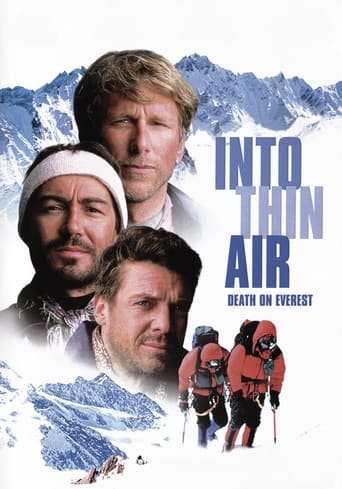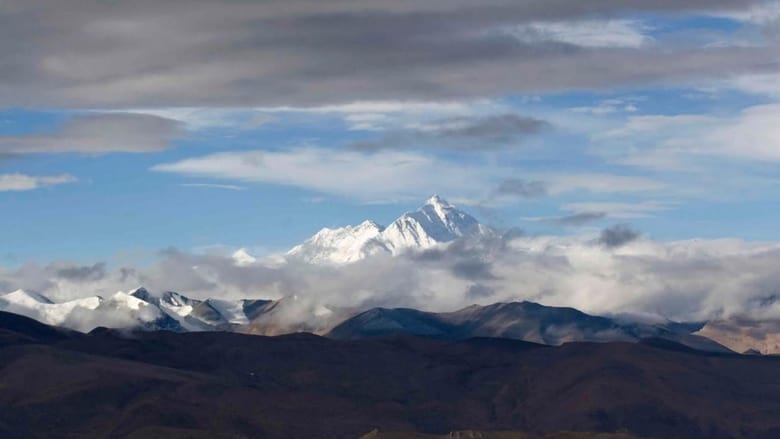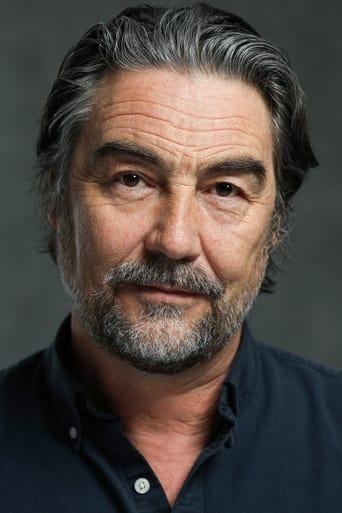Into Thin Air: Death on Everest (1997)
An adaptation of Jon Krakauer's best selling book, "Into Thin Air: A Personal Account of the Mt. Everest Disaster". This movie attempts to re-create the disastrous events that took place during the Mount Everest climb on May 10, 1996. It also follows Jon Krakauer throughout the movie, and portrays what he was going through while climbing this mountain.
Watch Trailer
Cast
Similar titles


Reviews
Admirable film.
It's fun, it's light, [but] it has a hard time when its tries to get heavy.
What a freaking movie. So many twists and turns. Absolutely intense from start to finish.
At first rather annoying in its heavy emphasis on reenactments, this movie ultimately proves fascinating, simply because the complicated, highly dramatic tale it tells still almost defies belief.
Jon Krakauer's story of climbing Mount Everest earned him his first best seller. Climbing Mount Everest was something that I would have never thought about before until now. It seems exciting even though there have been many casualties of people achieving the difficult climb of almost 40,000 feet. This movie has a good cast featuring Christopher McDonald as Jon Krakauer, Peter Horton as team guide Scott Fischer, and Richard Jenkins as Beck Weathers. The story of the climb reminds me of a Perfect Storm. After they reach the summit, they face treacherous weather and casualties mount. It's question of survival, clash of egos, and arrogance as well as motivation and drive to achieve the almost impossible of reaching MOunt Everest and surviving the experience.
"Into Thin Air: Death On Everest" is a wonderful film and a good start into understanding -- if that is possible -- the need some people have to climb mountains. The film covers the main events of Krakauer's experience and condenses characters to fit the needs of a 90 minute TV film. While the basics are here, the story has been greatly slimmed down and the amount of time involved, truncated. For instance, I would have liked to have seen the daring helicopter rescue by a very brave Nepalese army pilot. To mark a landing spot, those on the mountain made a large X in the snow with a red sports drink.Since the film was produced directly from Krakauer's book, it does not reference other accounts. Krakauer later admitted that some of the details he wrote were incorrect because he was as addled as everyone else, mistaking one climber for another. Krakauer's book is only one of several accounts of the tragic climb that took a fifteen lives in all. This movie could have used an extra half hours to cover more details, but it is fair to say that this is not meant to be a documentary. It comes down to a study of human hubris when faced with the drive to challenge the highest peak on Earth.For those who want to understand the complexity of the real drama, it is necessary to study the other points of view, some of which contradict Krakauer. A good second film to watch is the IMAX film "Everest" which was filmed during the same climb. Anatoli Boukreev wrote a reply to Krakauer in his book "The Climb: Tragic Ambitions on Everest." Scott Fisher's lead Sherpa, Lopsang, also responded to Krakauer's criticisms in writing. Tragically, both Boukreev and Lopsang died in separate climbing accidents not long after the fatal Everest events (Lopsang in September 1996 and Boukreev in December 1997).For those who wonder about what it would be like to climb Everest, it is much safer to watch the film. It is about all the experience most of us will ever need.
As someone who has read Jon Krakauers novel I was really interested in this movie although I did not expect much and how right I turned out to be. The movie is extremely rushed, we are barely introduced to the expedition members and already we go up to the summit. In only a few days of course because nearly everything concerning the preparations, the partially really amusing incidents in basecamp, the acclimatisation was cut out of the movie to show us a rush, no a blitz up the summit. The other expeditions, especially those responsible for a lot of the disaster because they were completely incompetent and inexperienced from Taiwan e.g. and the Indians who perished in the storm are ignored (Indians) or have minimum appearance (Taiwanese, I hated these jerks when I read the book). And although I am not an alpinist myself I did not believe a second this movie showed us Mt. Everest but some mountain in a much lower mountain range (actually Austrian Alps). I mean they are supposed to stand on the highest summit worldwide and in the background you see at least one clearly higher summit, how cheap is that? Well it is obviously as cheap as this movie was although the actors are really trying but they cannot create sympathy for their paper-thin characters with the few lines they got from this poorly written script. But I simply cannot take (or even stand) a scene seriously where a professional mountain climber in the midst of a snowstorm in the death zone takes of his gloves, breathing mask and other protections for no reason whatsoever...only perhaps because we shall see his face's expressions in a death scene? Too inaccurate for a documentation and not good or interesting enough for a movie-drama. And that the other 7! deaths of this day were not even mentioned in the epilogue was quite tasteless. Because the movie was fairly entertaining and the actors at least tried 3 out of 10.
Tragic but true story about the disastrous mountain climbing expedition of Mount. Everest in the spring of 1996. Two teams assemble at the foot of Everest headed by world renowned mountain climbers Rob Hall and Scott Fischer with a group of armatures climbers who paid as much as $65,000.00 apiece for the opportunity to scale the highest point on earth; the 29,028 foot five and a half mile high Mount. Everest.Slowly moving up Everest's snowy slopes the teams reach Camp #3 which is just under what is called the "Death Zone" 26,000 feet up where you can't can't survive without an oxygen mask for any long period of time. What these dizzying heights do is cause your lungs to work four times as hard pumping the same amount of air that they normally get at sea level.The brain then swells up causing unbelievably painful headaches with the lungs filling up with liquid, that if not immediately attended to, can drown you. Then your body becomes so starved for nutrients that it starts to literally feed on itself. This is what happens to a mountain climber reaching these heights, +20,000 feet, who's not fully aware and prepared for the reception that he'll get up there from Mother Nature.Going towards the Everest summit in sub-freezing weather the men, and women, of the expedition scale the dangerous "Hillery Step" which is the last step to climb before reaching the very top. Told by Scott that if it's 2:00PM to immediately start back down, even if the climbers are within 50 yards of the summit, his words are ignored. The climbers instead of turning back after the dreaded 2:00PM deadline keep climbing and one by one they all reach the top of Everest between the 2;00PM cut-off point until as late as 4;45PM which turned out to be a fatal mistake on their part. Earlier on the climb at camp #1 Sherpa guide Ang Dorge spotted two of the climbers, a man and woman, embracing outside their tent and got very upset feeling that they, not being married, were very disrespectful to the mountain and that it would lead to an angry response from Everest. Being told by climber and writer Jon Krakaur that it's not unusual for an unmarried couple to have relations back home in America. Jon is reminded by Ang Dorge that their in Napal not in America and what he's saying has nothing to do with native superstitions but that it's based experience and reality. Later when the climbers make their chilling decent from the mountain they find out just how real Ang Dorge's words really were.Leaving late in the afternoon to climb down the mountain, after planting flags and taking photos on Everest's summit, an unexpected storm kicked up and engulfed the entire summit area in darkness with 70 MPH winds and wind-chill temperatures of under -100 degrees. A number of the climbers started getting lost in the snowstorm and then ended up freezing to death. Among those who perished in the snows of Everest were the two team leaders of the exportation Scott Fischer and Rob Hall. The story of the climb is told to us in flashback by the author of the book "Into Thin Air: Death on Everest" writer Jon Krakaur who also was on the expedition but unlike some of his fellow mountain climbers lived to tell, as well as write, about it.










